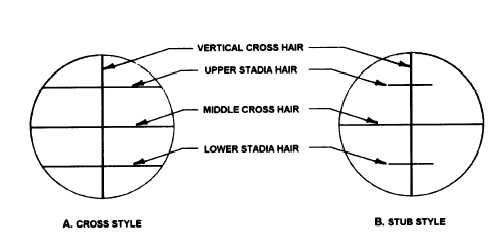1.
2.
3.
4.
5.
Figure 8-2.-Stadia hairs.
measure the angle and distance from transit
stations
measure angles from two transit stations
measure distances from two known points
measure an angle from one station and distance
from another station
measure swing offsets and range ties
As you can well imagine, detailing by transit and
tape is a time-consuming process that requires chaining
many distances and taking many level shots. This is
necessary when a high degree of accuracy is required.
However, for lower-precision (third and fourth order)
surveys, a less time-consuming method is to locate the
details by transit and stadia.
LOCATING DETAILS BY
TRANSIT AND STADIA
As an EA, most of the topographic surveying that
you will do is of a lower degree of accuracy that is well
suited to the transit and stadia method. When you are
using this method, horizontal distances and differences
in elevation are indirectly determined by using
subtended intervals and angles observed with a transit
on a leveling rod or stadia board To explain the meaning
of this, we will first discuss the principles of stadia and
then look at field procedures that are used in stadia work.
Stadia Equipment Terms, and Principles
The following discussion will familiarize you with
the equipment, terminology, and principles used in
stadia surveying. Although this discussion of stadia
surveying is included in this chapter on topography, you
should be aware that stadia can be used in any situation
in which it is desired to obtain horizontal distances and
differences in elevation indirectly. The results, though,
are of a lower order of precision than is obtainable by
taping, EDM, or differential leveling. However, the
results are adequate for many purposes, such as
lower-order trigonometric leveling.
A thorough understanding of stadia is highly
important to any surveyor. You should supplement the
knowledge that you gain from the following discussion
by reading other books, such as Surveying Theory and
Practice, by Davis, Foote, Anderson, and Mikhail.
STADIA RODS.— Where sight distances do not
exceed 200 feet, a conventional rod, such as a
Philadelphia rod, is adequate for stadia work. For longer
distances, however, you should use a stadia rod. Stadia
rods usually have large geometric designs on them so
that they may be read at distances of 1,000 to 1,500 feet
or even farther. Some rods do not have any numerals on
them. From the geometric pattern on the rod, you can
observe intervals of a tenth of a foot and sometimes a
hundredth of a foot.
Stadia rods generally are 10 to 15 feet long, 3 to 5
inches wide, and about 3/4 inch thick. They may be
made in one piece or in sections for ease in carrying
them. Some stadia rods are flexible and maybe rolled
up when not in use. Flexible rods are merely graduated
oilcloth ribbons, tacked to a board.
Some examples of stadia rods are shown in chapter
11 of the EA3 TRAMAN.
STADIA HAIRS.— The telescope of transits (as
well as theodolites, plane-table alidades, and many
levels) is equipped with two hairs, called stadia hairs,
that are in addition to the regular vertical and horizontal
cross hairs. Figure 8-2 shows two types of stadia hairs
as viewed through a telescope. As shown in this figure,
one stadia hair is located above and the other an equal
distance below the horizontal (or middle) cross hair. On
most equipment, the stadia hairs are not adjustable and
remain equally spaced.
8-3



